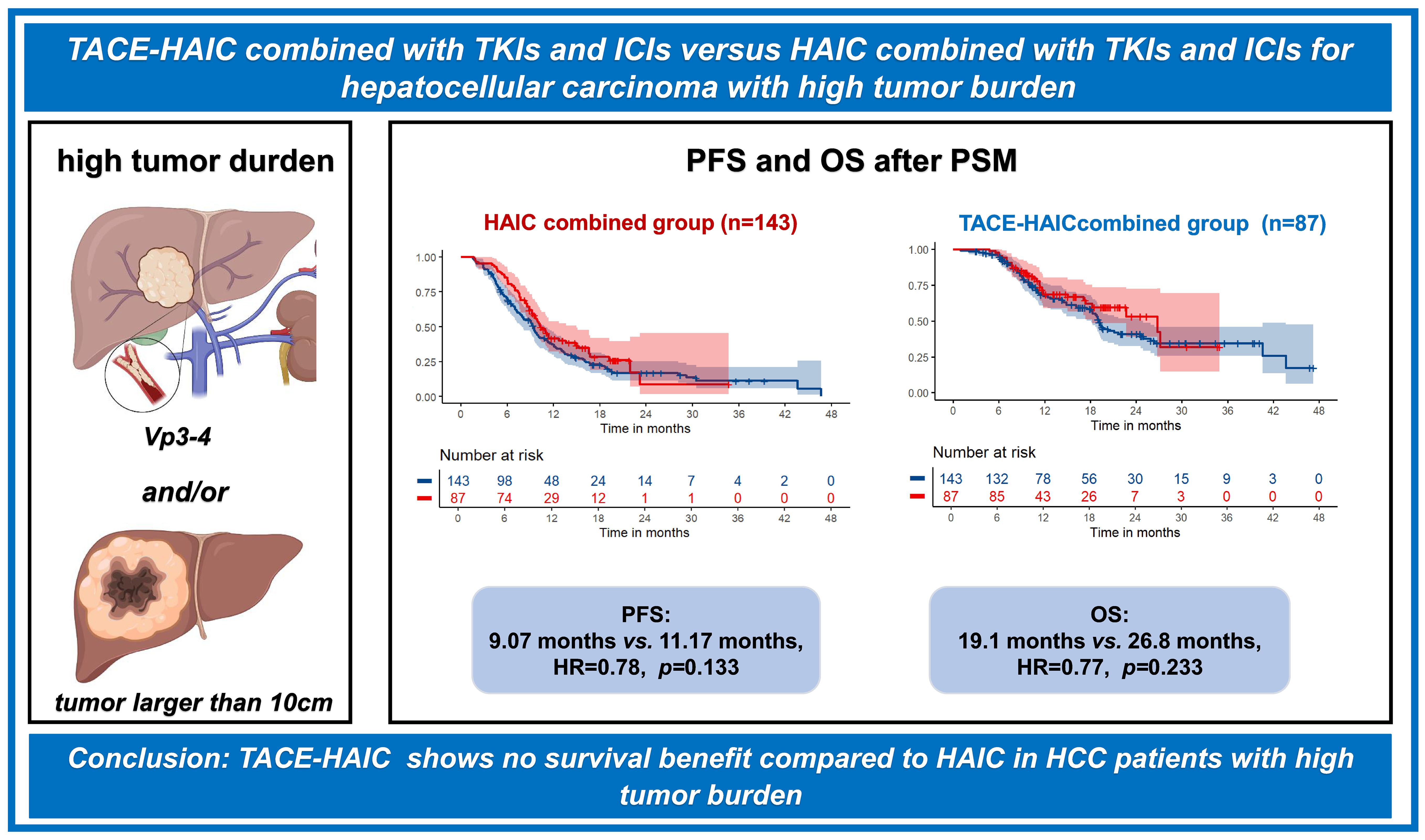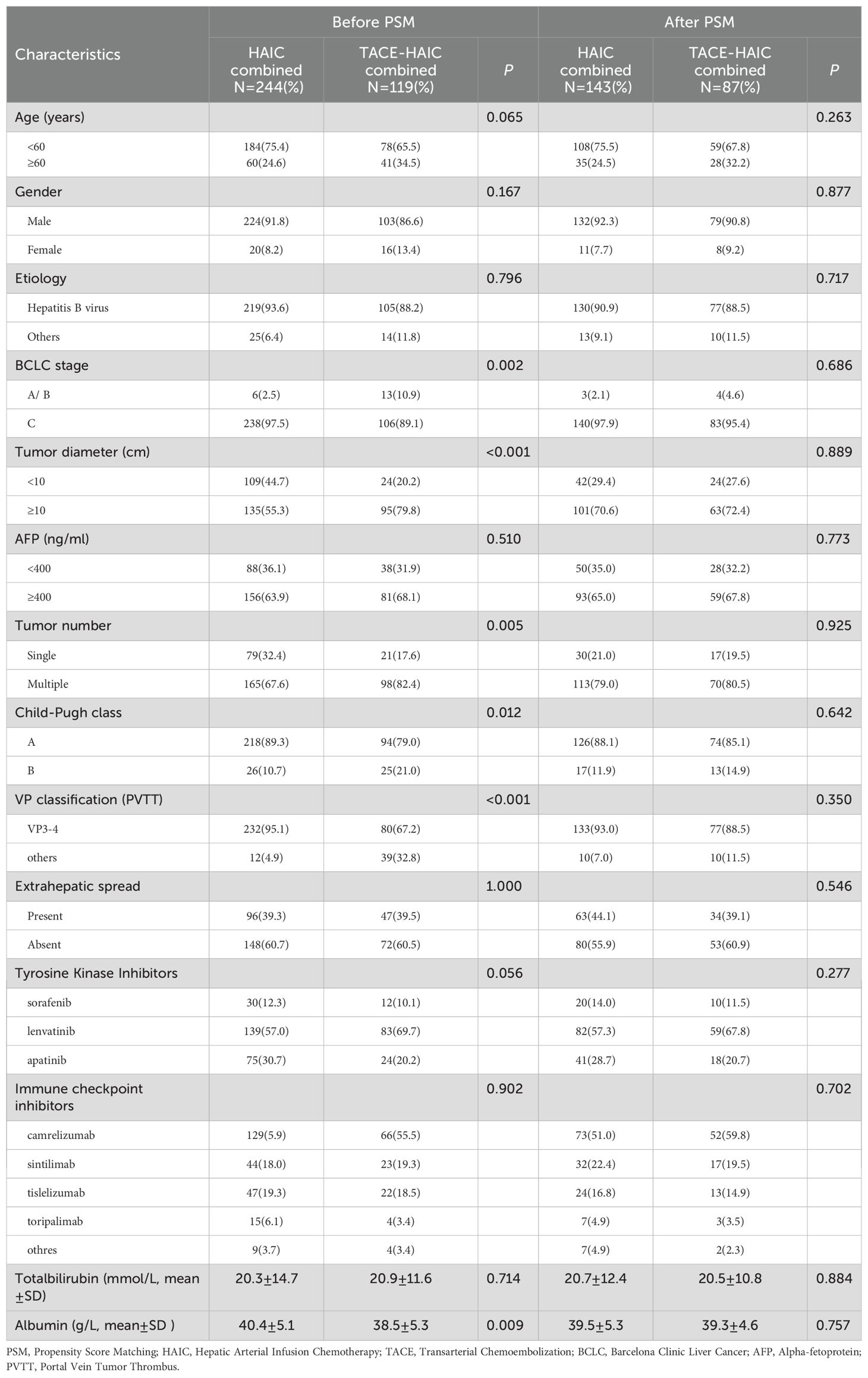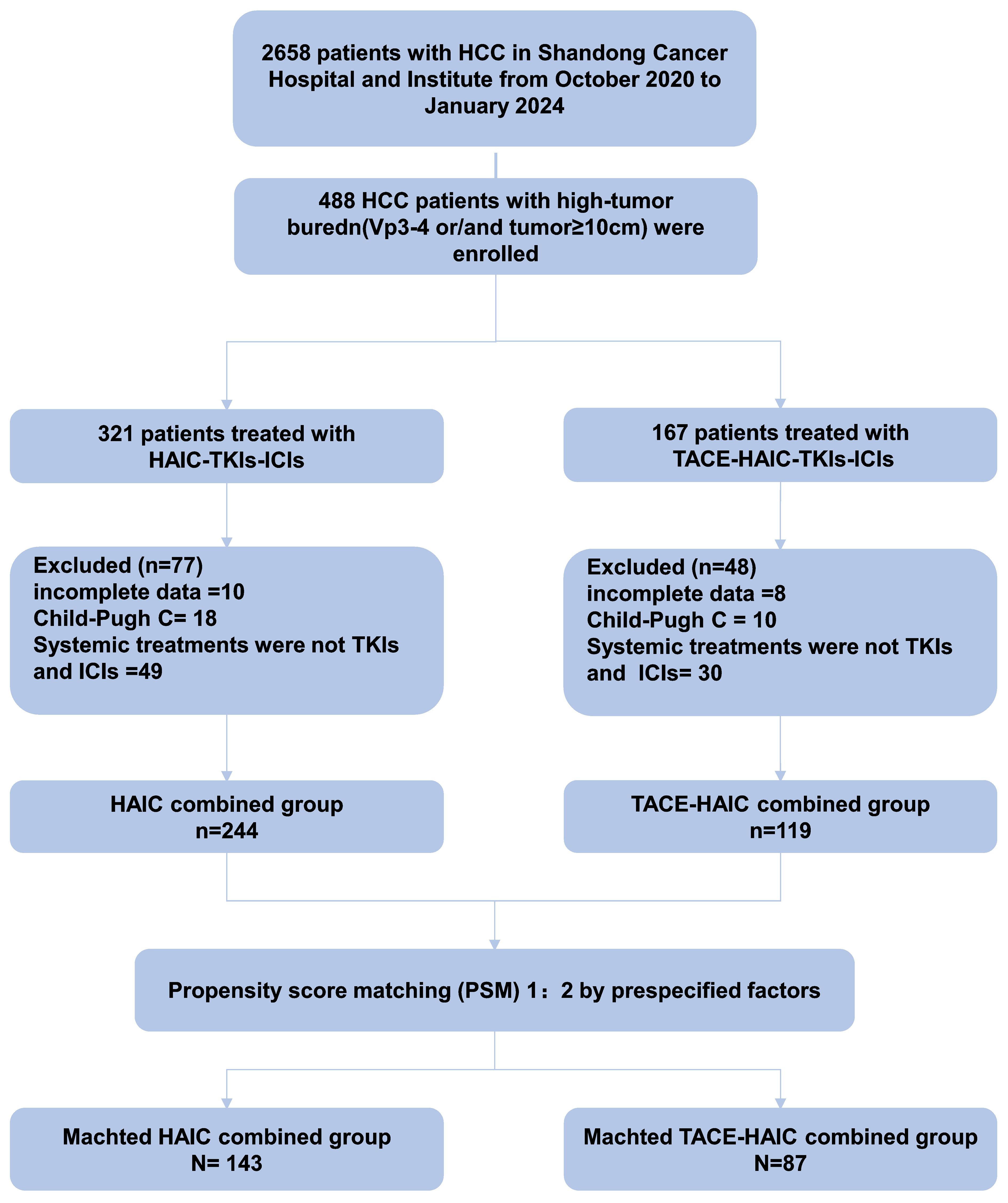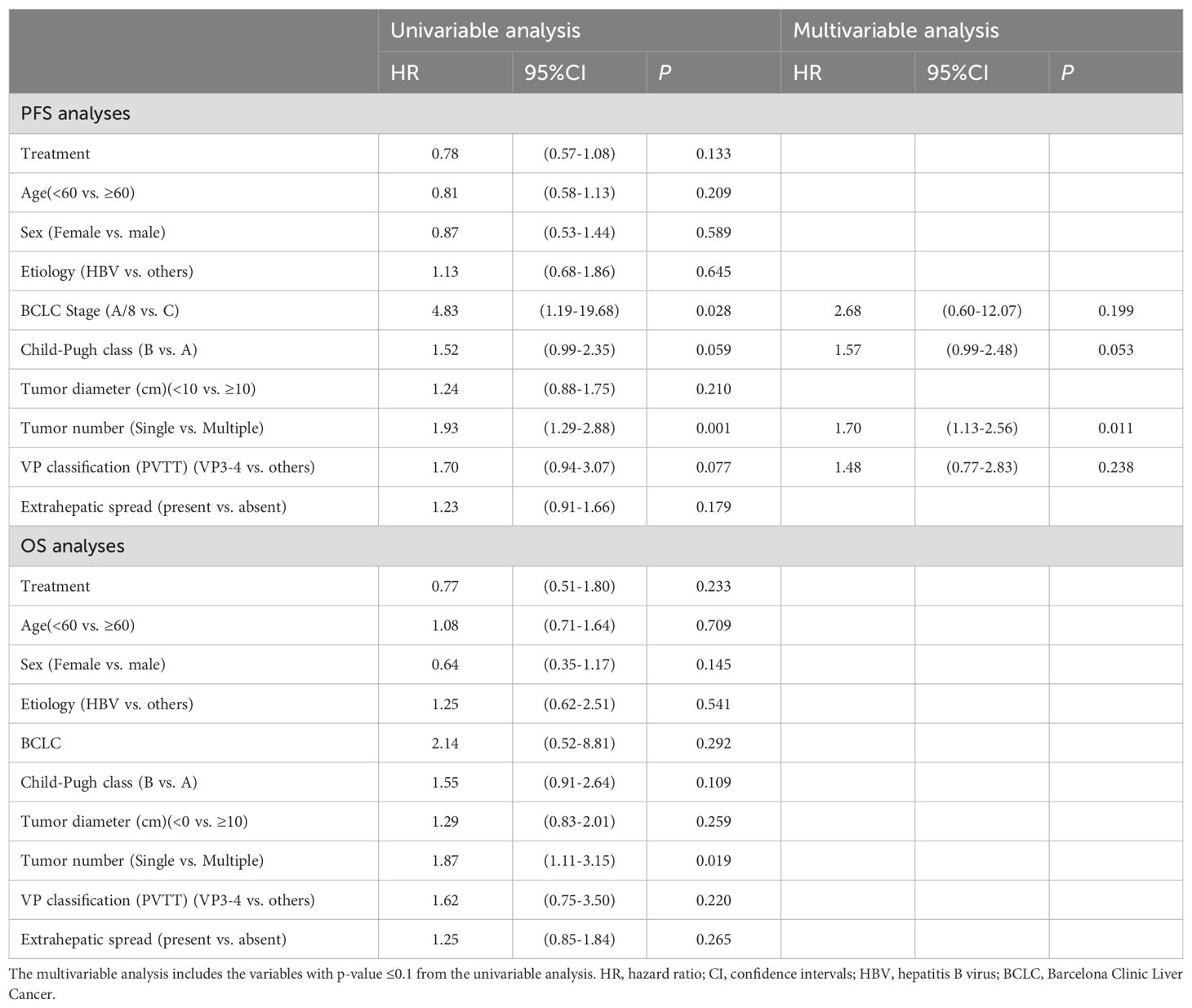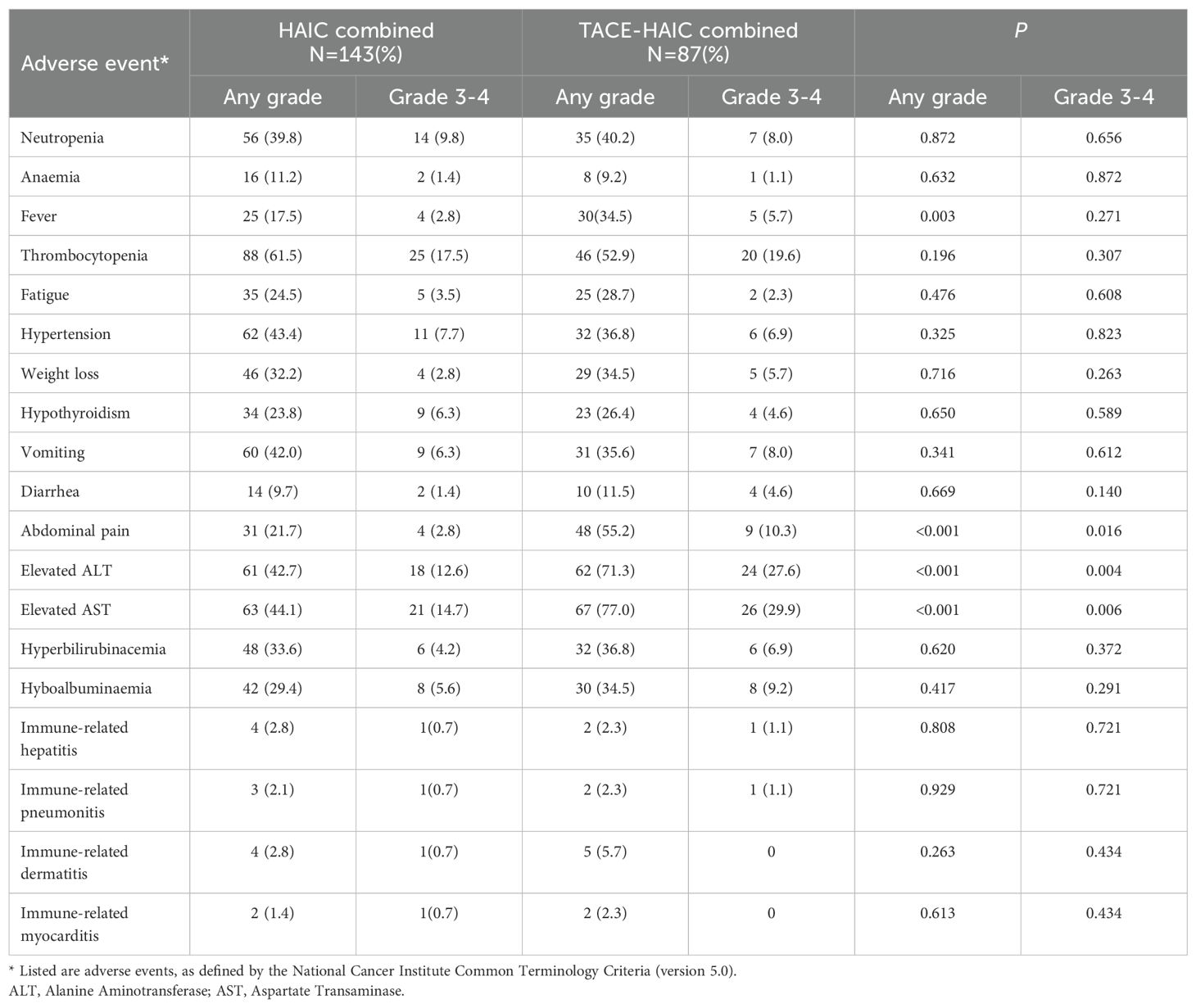- 1Shandong Tumor Hospital, Jinan, China
- 2Tianjin Baodi Hospital, Tianjin, China
- 3Central Hospital Affiliated to Shandong First Medical University, Jinan, China
Purpose: The present study aimed to comparatively examine transarterial chemoembolization (TACE) plus hepatic arterial infusion chemotherapy (HAIC) in combination with tyrosine kinase inhibitors (TKIs) and immune checkpoint inhibitors (ICIs) versus HAIC alone in combination with TKIs and ICIs for efficacy and safety in individuals with high tumor burden (major portal vein tumor thrombosis [PVTT] Vp3–4 or/and tumors larger than 10 cm) hepatocellular carcinoma (HCC).
Methods: Totally 363 inoperable HCC cases with high tumor burden administered TACE-HAIC plus TKI and ICI (TACE-HAIC combination group, n=119) or HAIC plus TKI and ICI (HAIC combination group, n=244) were recruited between October 2020 and January 2024, and propensity score matching (PSM) was utilized for matching patients. Overall survival (OS), progression-free survival (PFS), objective response (ORR), disease control (DCR) rates, and safety signals were assessed.
Results: Following PSM (1:2), 87 cases in the TACE-HAIC combination group were matched to 143 cases in the HAIC combination group. Median OS (26.8 vs. 19.1 months, p = 0.233) and PFS (11.17 vs. 9.01 months, p = 0.133) were similar in the TACE-HAIC and HAIC combination groups. ORRs were 58.0% and 64.4% in the HAIC and TACE-HAIC combination groups, respectively (p = 0.341). DCR were 90.9% and 94.3% for these groups, respectively (p = 0.360). Both univariate and multivariate analyses revealed no differences between the two groups pre- and post-matching. The commonest adverse events (AEs) included thrombocytopenia, hypertension, and increased AST (aspartate aminotransferase) and ALT (alanine aminotransferase) of any grade pre- and post-PSM.
Conclusions: For HCC patients with high tumor burden, HAIC demonstrates comparable efficacy to TACE-HAIC both in combination with TKIs and ICIs. Therefore, HAIC should be the preferred local therapeutic strategy over TACE-HAIC in HCC patients with high tumor burden.
Introduction
Hepatocellular carcinoma (HCC) ranks as the sixth most prevalent cancer and the third leading cause of cancer-related mortality globally (1, 2). Approximately 72% of all HCC cases are detected in Asian countries (3), with China comprising >50% (3). The majority of HCC diagnoses occur at advanced disease stages because of the insidious onset of this malignancy, when curative surgical resection is infeasible, leading to a meager 5-year survival rate of 10-18% (4, 5). HCC cases commonly have a high tumor burden (tumor larger than 10 cm, major portal vein tumor thrombosis (PVTT) Vp3-4) often manifesting as prevalent features (6). Such high-tumor-burden profiles are particularly common in Chinese patients, contributing to their extremely poor prognosis (3).
The development of systemic therapies has brought new hope for advanced HCC cases. Currently, atezolizumab + bevacizumab is advocated as the first-line therapeutic regimen in unresectable advanced HCC (7). Additionally, clinical trials, e.g., KEYNOTE-524 and CARES-310, have revealed that using tyrosine kinase (TKIs) and immune checkpoint (ICIs) inhibitors in combination has promising efficacy in advanced HCC (8, 9). However, patients with high tumor burden continue to experience suboptimal outcomes from the above therapies, attributed to their intrinsically unfavorable survival prognosis. This emphasizes the urgency to investigate more effective combinations of treatment strategies.
As demonstrated previously by our team, hepatic arterial infusion chemotherapy (HAIC) applied in combination with lenvatinib and ICIs represents a safe and effective treatment approach in HCC cases showing high tumor burden, demonstrating substantially improved overall survival (OS), progression-free survival (PFS), and objective response rate (ORR) versus lenvatinib and PD-1 inhibitors, with tolerable toxicity (10–12). Recently, an interesting study reported atezolizumab + bevacizumab in combination with TACE-HAIC demonstrated promising outcomes, with a median PFS of 10.1 months (95% confidence interval [CI]: 8.4-NA) and the median OS still pending. At one year, OS and PFS rates were 92.8% (95%CI: 86.1-100.0) and 42.9% (95%CI: 31.3-58.7), respectively (13). TACE-HAIC is presently considered a relatively new local treatment modality, which reduces resistance to HAIC and prolongs patient survival (14–21). However, most studies on TACE-HAIC are single-arm or use TACE for comparison, with a direct comparison between TACE-HAIC and HAIC lacking. In light of the potential for improvement in HCC cases with high tumor burden, the present study was designed to compare the efficacy and safety of TACE-HAIC in combination with TKIs and ICIs to HAIC in combination with TKIs and ICIs, to determine a more suitable local therapeutic strategy.
Methods
Between October 2020 and January 2024, 363 inoperable HCC cases with high tumor burden were enrolled. HCC diagnosis was based on non-invasive methods or biopsy confirmation. Inclusion criteria were: (1) age of 18–80 years; (2) liver function as Child-Pugh class A or B; (3) Eastern Cooperative Oncology Group (ECOG) performance status of 0-2; (4) confirmation of Vp3–4 or/and tumor diameter ≥10 cm; (5) measurable liver tumor(s) per response evaluation criteria in solid tumors 1.1 (RECIST 1.1); (6) no prior systemic therapy. Exclusion criteria were: other concurrent malignancies, incomplete patient records, or loss to follow-up.
The present single-center retrospective study was approved by the Ethics Committee of our institution (SDTHEC 202410032). Written informed consent for the use of clinical data in research was obtained from all participants at the time of treatment. Data were de-identified by removing personal identifiers, following the Declaration of Helsinki 1955.
Treatment protocol
Oral TKIs were initiated 3–7 days before treatment initiation for tolerance assessment. TKIs included sorafenib, lenvatinib, apatinib, and donafenib. Doses were adjusted for toxic effects as necessary. All TKIs were administered per the package inserts. Dose adjustment was performed according to the package insert when clinically necessary. PD-1 inhibitors such as sintilimab, camrelizumab, toripalimab, and tislelizumab were administered strictly in accordance with the respective specifications.
For HAIC, a microcatheter was positioned into the primary feeding hepatic artery for administering FOLFOX-based chemotherapy: oxaliplatin (85 mg/m2 for 0 to 2 h) on day 1, calcium folinate (400 mg/m2 for 2 to 3 h) on day 1, and fluorouracil (400 mg/m2 as a bolus at 3 h) on day 1, followed by 2400 mg/m2 over 46 h on days 1-2. After the initial HAIC procedure, the catheter and sheath were removed. Re-catheterization was performed for subsequent cycles. Maintenance therapy with TKIs and ICIs was continued thereafter. HAIC was conducted at 3–4-week intervals as needed.
TACE-HAIC was carried out as reported previously (22, 23). In brief, chemoembolization was conducted with 30 mg/m2 of epirubicin, lobaplatin 50 mg or raltitrexed added to 2–5 mL of lipiodol (10ml, 895 RMB). Next, up to 20 mL of lipiodol was administered by injection into the tumor-feeding artery until blood stasis in the target artery. The dose of chemoembolization lipiodol was based on the patient’s liver function, tumor size, vascularity, and body surface area. Additionally, gelatin sponge (Gelfoam150, 1050 RMB) particles were utilized if necessary. If an artery–portal vein fistula was performed, it was occluded before mixture embolization by a spiral steel ring based on angiography images and the doctor’s experience. Then, a catheter was positioned in the tumor-feeding artery, followed by fixation for the infusion of FOLFOX-based chemotherapeutics as the HAIC procedure. Repeated TACE-HAIC was conducted at 3–4-week intervals. The definitions of HAIC combination and TACE-HAIC combination groups are found in Supplement Pages 1-4, Supplementary Figures S1–S4.
Follow−up and response assessment
Treatment responses were examined by two investigators, followed by verification by an independent radiologist. The primary tumor response was assessed employing RECIST 1.1. The anticancer effect was evaluated by OS, PFS, ORR, and disease control rate (DCR). OS was defined as the duration from initial HAIC therapy to death or the final follow-up, while PFS was the interval from initial HAIC therapy to disease progression or final follow-up. ORR was the rate of cases with complete (CR) or partial (PR) response, and DCR represented the percentage of cases with CR, PR, or stable disease (SD).
Adverse effects linked to treatment were recorded, e.g., hematotoxic and gastrointestinal effects, liver function changes, and immune-associated events.
Statistical analysis
To minimize confounders and decrease selection bias, propensity score matching (PSM) was conducted, using 1:2 nearest-neighbor matching with no replacement, employing a caliper width of 0.05. Propensity scores were obtained by logistic regression utilizing covariates such as sex, age (<60 vs. ≥60), hepatitis B virus (HBV) infection (absent vs. present), tumor size (<10 cm vs. ≥10 cm), Child-Pugh grade (A vs. B), BCLC stage (A/B vs. C), extrahepatic spread (absent vs. present), Vp3-4 (absent vs. present), and tumor number (single vs. multiple).
Kaplan-Meier curve analysis was performed for survival outcomes, with the log-rank test utilized to compare groups. Univariable and multivariable analyses were conducted by Cox regression. Data were analyzed using R version 4.2.2 (R Foundation for Statistical Computing, Austria). Two-sided P<0.05 reflected statistical significance.
Results
Patient features
Totally 363 patients were enrolled in xxxx Hospital, of whom 119 were administered TACE-HAIC plus TKI and PD-1 (TACE-HAIC combination group) and 244 received HAIC plus TKI and PD-1 (HAIC combination group). Figure 1 depicts the study flowchart. Before PSM, the HAIC combination group had more patients at the BCLC C stage (97.5% vs. 89.1%, p = 0.002) and more cases with VP3-4 (95.1% vs. 67.2%, p < 0.001). Meanwhile, the TACE-HAIC combination group included more patients with a tumor diameter over 10 cm (79.8% vs. 55.3%, p < 0.001) and more cases with multiple lesions (82.4% vs. 67.6%, p = 0.005). After PSM (1:2), 87 cases in the TACE-HAIC combination group were matched to 143 in the HAIC combination group. Baseline features were comparable post-PSM in both groups (all p>0.05; Table 1 and Supplementary Figures S5, S6).
Efficacy
Before PSM
Median follow-up times were 23.63 (95%CI: 20.78-26.48) months and 17.60 (95%CI: 14.85-20.35) months in the HAIC combination and TACE-HAIC combination groups, respectively (p < 0.001). Totally 45 (37.8%) of 119 cases in the TACE-HAIC combination group and 122 (50.0%) of 244 in the HAIC combination group showed disease progression or died. Median PFS durations were 9.43 months in the HAIC combination group (95%CI: 8.07–10.7) and 10.97 months in the TACE-HAIC combination group (95%CI: 9.87–15.1), indicating no statistical significance (p = 0.104). Median OS durations were 19.3 months (95%CI: 18.1–25.9) and 26.8 months (95%CI: 18.2–NA) in the HAIC combination and TACE-HAIC combination groups, respectively, with no significant difference between the two groups (p = 0.53, Figure 2). ORRs were 59.9% and 63.0% in the HAIC combination and TACE-HAIC combination groups, respectively (p = 0.559); DCRs were 92.7% and 92.4%, respectively (p = 0.949, Table 2).

Figure 2. Kaplan–Meier curves of progression-free survival and overall survival before (A, B) and after (C, D) matching.
After PSM
Median follow-up times were 24.07 (95%CI: 21.52-26.62) months in the HAIC combination group and 17.30 (95%CI: 13.18-21.43) months in the TACE-HAIC combination group (p < 0.001). Totally 31 (35.6%) of 87 cases in the TACE-HAIC combination group and 74 (51.7%) of 143 in the HAIC combination group showed disease progression or died. Median PFS durations were 9.07 months (95%CI: 7.60–10.1) and 11.17 months (95%CI: 9.93–16.6) in the HAIC combination and TACE-HAIC combination groups, respectively, indicating no statistical significance (p = 0.133). Median OS durations were 19.1 months in the HAIC combination group (95%CI: 18.1–24.9) and 26.8 months in the TACE-HAIC combination group (95%CI: 18.2–NA), also suggesting no statistical significance (p = 0.233, Figure 2). ORRs were 58.0% and 64.4% in the HAIC and TACE-HAIC combination groups (p = 0.341); DCRs were 90.9% and 94.3%, respectively (p = 0.360, Table 2).
Subgroup analysis
After PSM, univariable and multivariable analyses by COX regression (Table 3) revealed tumor number (HR = 1.70, 95%CI: 1.13-2.56; p = 0.011) as the sole factor independently affecting PFS. Before PSM, VP classification (PVTT) independently predicted PFS. Univariable and multivariable analyses showed no statistically significant differences in OS between the two groups before and after matching (Supplementary Table S1, Table 3). Subgroup analysis also showed no statistically significant differences between the two groups (Supplementary Figure S7, Figure 3).
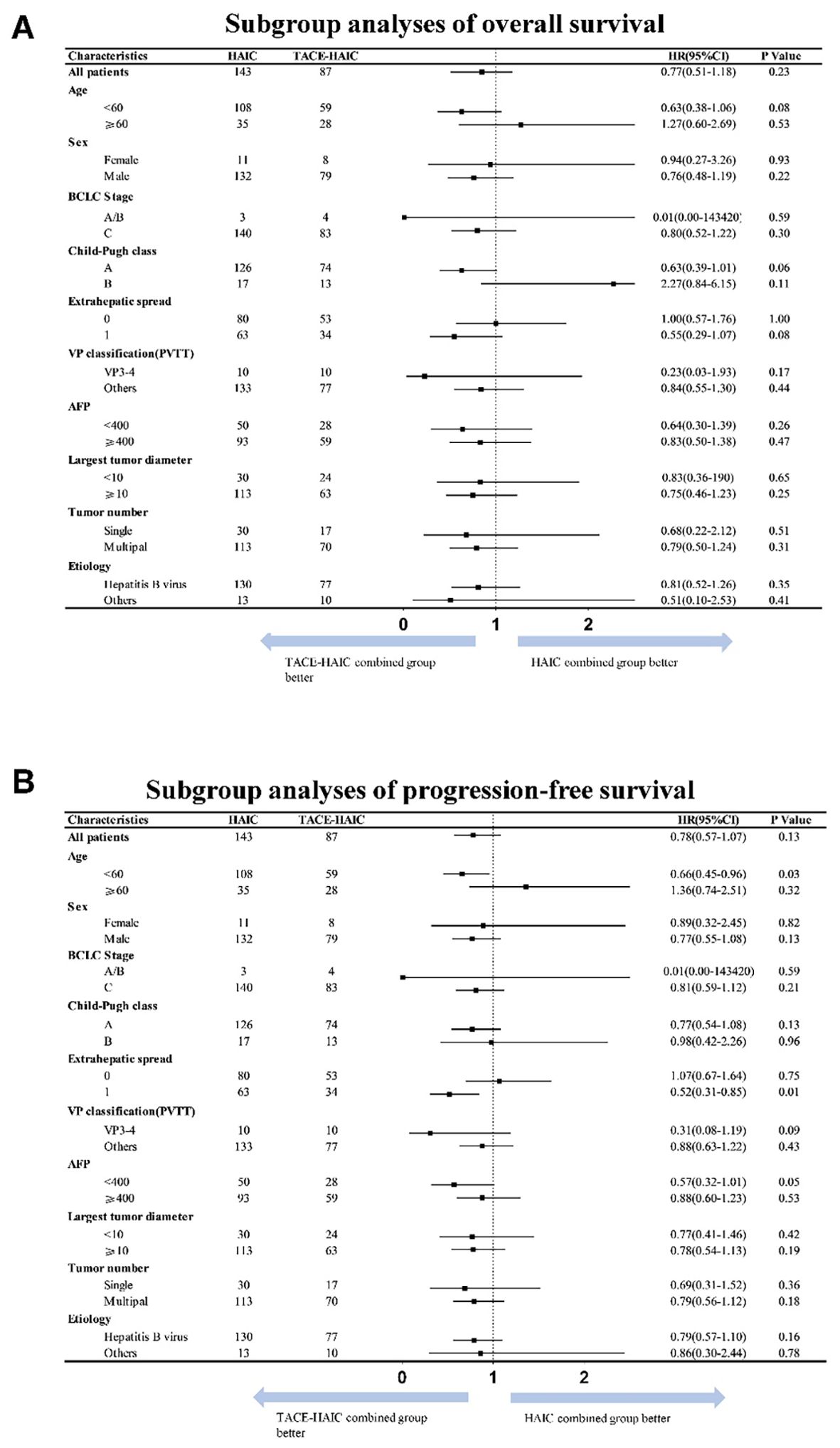
Figure 3. Subgroup analysis of progression-free survival (A) and overall survival (B) after matching.
Safety
The commonest adverse events (AEs) encompassed thrombocytopenia, hypertension, and increased AST (aspartate aminotransferase) and ALT (alanine aminotransferase) of any grade pre- and post-PSM. However, the TACE-HAIC combination group had elevated rates of fever, abdominal pain, ALT increase, and AST increase of any grade (p < 0.05), and grade 3–4 ALT and AST increases (p < 0.05) (Supplementary Table S2, Table 4).
Discussion
Currently, combination therapies represent the trend in HCC management, and both targeted therapy plus immunotherapy and dual immunotherapy yield promising results. Additionally, TACE and HAIC constitute two commonly used interventional treatment methods (24). Could the combination of these two tools also confer survival benefits? To answer this question, the present study aimed to compare TACE-HAIC plus TKIs and ICIs to HAIC plus TKIs and ICIs for efficacy and safety to determine a more suitable local therapeutic strategy. However, in this study, HAIC and TACE-HAIC had no statistically significant differences in patients with high tumor burden when combined with TKIs and ICIs (median OS, 26.8 vs. 19.1 months, p = 0.233; median PFS, 11.17 vs. 9.01 months, p = 0.133). In a previous study, HAIC showed clear advantages over TACE in cases with tumors surpassing 7 cm (17). Similarly, HAIC demonstrated better efficacy versus TACE in cases with Vp4 involvement and hepatic arterioportal vein shunts (25). Considering the above findings, we hypothesize that HAIC may be highly important in treating patients with high tumor burden.
The reasons for no survival difference between the HAIC combination and TACE-HAIC combination groups are 1) tumor size (median tumor sizes in both groups all surpassed 10 cm [10.1 cm and 11.8 cm, respectively]) and 2) macrovascular invasion (most patients had macrovascular invasions, e.g., portal vein and hepatic vein invasion).
Regarding tumor size, previous evidence suggests a markedly lower rate of complete tumor response for large HCCs (>5 cm) versus smaller ones (25% vs. 64%) (26). A recent randomized phase III trial further highlighted the superiority of HAIC over TACE in individuals with large, unresectable HCCs (>7 cm), reporting OS of 23.1 months versus 16.1 months (27). Additionally, large HCCs require a high volume of embolic agents injected into the tumors, which may elevate the risk of liver function deterioration, post-embolization syndrome, and non-target embolization. However, whether chemotherapeutic drugs effectively enter the tumor following embolization remains unclear. As a result, TACE-HAIC shows no superior benefit over HAIC in patients with HCC lesions above 10 cm.
For macrovascular invasion, clinically, portal vein invasion often results in hepatic arterioportal vein fistula, which might induce embolic agents to migrate into the portal vein, increasing the risk of portal hypertension, esophagogastric varices rupture, and liver dysfunction. In case of hepatic vein invasion, small embolic agents can traverse the shunts to the inferior vena cava and pulmonary artery, inducing complications, e.g., dry cough from micropulmonary embolism. Furthermore, embolic agents can even enter the circulatory system via abnormal shunts, which may induce serious complications such as cerebral infarction. Therefore, in patients with macrovascular invasion, it is difficult for the lipiodol to deposit inside the tumor; instead, most of it is more likely lost via hepatic arteriovenous shunt. This may be the reason why TACE-HAIC is not effective for patients with PVTT (Vp3-4).
Examining previous studies on TACE-HAIC, several points worth discussing were identified. Firstly, the concept of TACE-HAIC needs clarification. How should the cases be defined if the tumor’s extrahepatic branches are embolized (e.g., internal mammary, renal capsular, and gastroduodenal arteries) and the microcatheter is retained in the hepatic artery to perfuse the main tumor-feeding vessels? As demonstrated in the Supplementary Material (Page 1-4, Supplementary Figures S1–S4), the “TACE-HAIC technique” should ensure that the embolization and perfusion areas exactly define the same area. All the individuals included in the TACE-HAIC group in this study met this criterion. Secondly, previous studies only pointed out the selection of chemotherapeutic drugs and the dosage of iodized oil embolization used in TACE-HAIC, not indicating how to deal with patients with hepatic arterioportal vein or hepatic arterio-hepatic vein shunts and whether sponge embolization should be given. Moreover, after complete embolization, when blood vessels are blocked, whether chemotherapeutic drugs can enter the tumor to the greatest extent is unknown. Additionally, unlike HAIC, the “TACE-HAIC technique” is hard to standardize, which makes its promotion difficult. Finally, the majority of existing reports assessing TACE-HAIC are single-arm studies or comparisons with TACE. Although TACE-HAIC has shown significantly improved survival benefits compared with TACE (14–20), we cannot rule out the possibility that some patients may benefit from HAIC. Currently, no study has compared TACE-HAIC and HAIC for efficacy.
Combining the current findings and previously reported data (21), there is substantial evidence to believe that HAIC plays as the pivotal component in the TACE-HAIC regimen, while TACE may contribute no therapeutic benefits but increase the incidence of AEs. An elevated rate of individuals in the TACE-HAIC combination group had fever, abdominal pain, and elevated ALT and AST of any level (p < 0.05), and grade 3–4 ALT and AST elevations (p < 0.05) (Supplementary Table S2, Table 4). On the other hand, use of embolic agents and chemotherapeutic drugs in TACE increases the economic burden on patients. From this standpoint, the TACE-HAIC regimen fails to demonstrate synergistic benefits.
The current study had multiple limitations. First, as a retrospective analysis, selection bias and absence of randomization are inevitable, even after PSM. Secondly, the follow-up period was short, with an insufficient number of OS events to draw definitive conclusions about the long-term therapeutic benefits, warranting long-term survival analyses. Thirdly, all cases were recruited from a single center, which limits data generalizability.
In light of these limitations, future prospective, multi-center randomized controlled trials (RCTs) are urgently needed to validate the current findings. Such RCTs should be designed with longer follow-up periods, comprehensive subgroup analyses, and biomarkers to fully compare the safety, efficacy, and clinical value of TACE-HAIC and HAIC in patients with high-tumor-burden HCC.
Conclusion
Among HCC patients with high tumor burden, HAIC demonstrates comparable efficacy to TACE-HAIC both in combination with TKIs and ICIs. However, TACE-HAIC increases the financial burden on patients, induces further adverse events, and provides no significant improvements in PFS or OS compared with the HAIC procedure. Thus, we recommend HAIC as the preferred local treatment for HCC patients with high tumor burden, rather than the TACE-HAIC treatment.
Data availability statement
The raw data supporting the conclusions of this article will be made available by the authors, without undue reservation.
Ethics statement
The studies involving humans were approved by the Ethics Committee of the Shandong First Medical University Affiliated Cancer Hospital. The studies were conducted in accordance with the local legislation and institutional requirements. The participants provided their written informed consent to participate in this study. Written informed consent was obtained from the individual(s) for the publication of any potentially identifiable images or data included in this article.
Author contributions
CW: Formal analysis, Software, Visualization, Writing – original draft, Writing – review & editing. YD: Data curation, Software, Writing – original draft, Writing – review & editing. XL: Investigation, Methodology, Writing – review & editing. WS: Supervision, Writing – review & editing. GW: Resources, Writing – review & editing. HW: Conceptualization, Data curation, Project administration, Resources, Writing – review & editing. XC: Data curation, Investigation, Supervision, Validation, Visualization, Writing – original draft, Writing – review & editing.
Funding
The author(s) declare that no financial support was received for the research, and/or publication of this article.
Conflict of interest
The authors declare that the research was conducted in the absence of any commercial or financial relationships that could be construed as a potential conflict of interest.
Generative AI statement
The author(s) declare that no Generative AI was used in the creation of this manuscript.
Any alternative text (alt text) provided alongside figures in this article has been generated by Frontiers with the support of artificial intelligence and reasonable efforts have been made to ensure accuracy, including review by the authors wherever possible. If you identify any issues, please contact us.
Publisher’s note
All claims expressed in this article are solely those of the authors and do not necessarily represent those of their affiliated organizations, or those of the publisher, the editors and the reviewers. Any product that may be evaluated in this article, or claim that may be made by its manufacturer, is not guaranteed or endorsed by the publisher.
Supplementary material
The Supplementary Material for this article can be found online at: https://www.frontiersin.org/articles/10.3389/fimmu.2025.1664756/full#supplementary-material
References
1. Hyuna S, Jacques F, Rebecca LS, Mathieu L, Isabelle S, Ahmedin J, et al. Global cancer statistics 2020: GLOBOCAN estimates of incidence and mortality worldwide for 36 cancers in 185 countries. CA Cancer J Clin. (2021) 71:209–49. doi: 10.3322/caac.2166
2. Rui-Mei F, Yi-Nan Z, Su-Mei C, and Rui-Hua X. Current cancer situation in China: good or bad news from the 2018 Global Cancer Statistics? Cancer Commun (Lond). (2019) 39:22. doi: 10.1186/s40880-019-0368-6
3. Qiuyan L, Xiaoquan H, Canmei Z, Tiancheng L, Xiaoqing Z, and Shiyao C. Improved survival with radiotherapy in hepatocellular carcinoma with major vascular invasion: A propensity-matched analysis of Surveillance, Epidemiology, and End Results database. Cancer Med. (2019) 8:515–26. doi: 10.1002/cam4.1937
4. Rebecca LS, Kimberly DM, and Ahmedin J. Cancer statistics, 2020. CA Cancer J Clin. (2020) 70:7–30. doi: 10.3322/caac.21590
5. Josep ML, Sergio R, Vincenzo M, Philip H, Edward G, Jean-Frédéric B, et al. Sorafenib in advanced hepatocellular carcinoma. N Engl J Med. 359:378–90. doi: 10.1056/NEJMoa0708857
6. Cheng A, Qin S, Ikeda M, Galle P, Ducreux M, Kim T, et al. Updated efficacy and safety data from IMbrave150: Atezolizumab plus bevacizumab vs. sorafenib for unresectable hepatocellular carcinoma. J Hepatol. (2022) 76:862–73. doi: 10.1016/j.jhep.2021.11.030
7. Finn R, Qin S, Ikeda M, Galle P, Ducreux M, Kim T, et al. Atezolizumab plus Bevacizumab in Unresectable Hepatocellular Carcinoma. New Engl J Med. (2020) 382:1894–905. doi: 10.1056/NEJMoa1915745
8. Finn R, Ikeda M, Zhu A, Sung M, Baron A, Kudo M, et al. Phase Ib study of lenvatinib plus pembrolizumab in patients with unresectable hepatocellular carcinoma. J Clin Oncol Off J Am Soc Clin Oncol. (2020) 38:2960–70. doi: 10.1200/jco.20.00808
9. Qin S, Chan S, Gu S, Bai Y, Ren Z, Lin X, et al. Camrelizumab plus rivoceranib versus sorafenib as first-line therapy for unresectable hepatocellular carcinoma (CARES-310): a randomised, open-label, international phase 3 study. Lancet (London England). (2023) 402:1133–46. doi: 10.1016/s0140-6736(23)00961-3
10. Chang X, Li X, Sun P, Li Z, Sun P, and Ning S. HAIC Combined with lenvatinib plus PD-1 versus lenvatinib Plus PD-1 in patients with high-risk advanced HCC: a real-world study. BMC Cancer. (2024) 24:480. doi: 10.1186/s12885-024-12233-6
11. Yidan L, Xiaoling Z, Pengfei S, and Xu C. Hepatic arterial infusion chemotherapy enhances the efficacy of lenvatinib plus PD-1 inhibitors in hepatocellular carcinoma patients with tumor thrombosis in the inferior vena cava and/or right atrium. Acad Radiol. (2025) 32:787–97. doi: 10.1016/j.acra.2024.08.058
12. Xu C, Huiyong W, Shangkun N, Xinge L, Yinfa X, Wenbo S, et al. Hepatic arterial infusion chemotherapy combined with lenvatinib plus humanized programmed death receptor-1 in patients with high-risk advanced hepatocellular carcinoma: A real-world study. J Hepatocell Carcinoma. (2023) 10:1497–509. doi: 10.2147/jhc.S418387
13. Zhenkun H, Tiejun C, Wenbin L, Wei H, Shaoru L, Zongfeng W, et al. Atezolizumab and bevacizumab plus transarterial chemoembolization and hepatic arterial infusion chemotherapy for patients with high tumor burden unresectable hepatocellular carcinoma: A multi-center cohort study. Int Immunopharmacol. (2024) 139:112711. doi: 10.1016/j.intimp.2024.112711
14. Li B, Qiu J, Zheng Y, Shi Y, Zou R, He W, et al. Conversion to resectability using transarterial chemoembolization combined with hepatic arterial infusion chemotherapy for initially unresectable hepatocellular carcinoma. Ann Surg Open. (2021) 2:e057. doi: 10.1097/as9.0000000000000057
15. Kondo Y, Morosawa T, Minami S, and Tanaka Y. DEB-TACE combined with hepatic artery infusion chemotherapy might be an affordable treatment option for advanced stage of HCC. Sci Rep. (2022) 12:16868. doi: 10.1038/s41598-022-21472-1
16. Liu B, Gao S, Zhu X, Guo J, Kou F, Liu S, et al. Combination Therapy of Chemoembolization and Hepatic Arterial Infusion Chemotherapy in Hepatocellular Carcinoma with Portal Vein Tumor Thrombosis Compared with Chemoembolization Alone: A Propensity Score-Matched Analysis. BioMed Res Int. (2021) 2021:6670367. doi: 10.1155/2021/6670367
17. Mingyue C, Licong L, Jian Z, Nianping C, Wensou H, Yongjian G, et al. Lenvatinib plus drug-eluting bead transarterial chemoembolization with/without hepatic arterial infusion chemotherapy for hepatocellular carcinoma larger than 7 cm with major portal vein tumor thrombosis: a multicenter retrospective cohort study. Int J Surg. (2024) 110:7860–70. doi: 10.1097/js9.0000000000001819
18. Guo W, Gao J, Zhuang W, Wu Z, Li B, and Chen S. Efficacy and safety of hepatic arterial infusion chemotherapy combined with transarterial embolization for unresectable hepatocellular carcinoma: A propensity score-matching cohort study. JGH Open. (2020) 4:477–83. doi: 10.1002/jgh3.12285
19. Huang J, Huang W, Zhan M, Guo Y, Liang L, Cai M, et al. Drug-eluting bead transarterial chemoembolization combined with FOLFOX-Based Hepatic Arterial Infusion Chemotherapy For Large Or Huge Hepatocellular Carcinoma. J hepatocellular carcinoma. (2021) 8:1445–58. doi: 10.2147/jhc.S339379
20. Gao S, Zhang P, Guo J, Chen H, Xu H, Liu P, et al. Chemoembolization alone vs combined chemoembolization and hepatic arterial infusion chemotherapy in inoperable hepatocellular carcinoma patients. World J Gastroenterol. (2015) 21:10443–52. doi: 10.3748/wjg.v21.i36.10443
21. Feng G, Feng Y, Yao S, Huang X, Peng Z, Tang Y, et al. Transcatheter arterial chemoembolization combined with hepatic arterial infusion chemotherapy versus transcatheter arterial chemoembolization for unresectable hepatocellular carcinoma: A systematic review and meta-analysis. Turkish J Gastroenterol. (2024) 35:266–79. doi: 10.5152/tjg.2024.23228
22. Yichuan Y, Wei H, Zhiwen Y, Jiliang Q, Zhenkun H, Yunxing S, et al. TACE-HAIC combined with targeted therapy and immunotherapy versus TACE alone for hepatocellular carcinoma with portal vein tumour thrombus: a propensity score matching study. Int J Surg. (2023) 109:1222–30. doi: 10.1097/js9.0000000000000256
23. Binkui L, Jiliang Q, Yun Z, Yunxing S, Ruhai Z, Wei H, et al. Conversion to resectability using transarterial chemoembolization combined with hepatic arterial infusion chemotherapy for initially unresectable hepatocellular carcinoma. Ann Surg Open. (2021) 2:e057. doi: 10.1097/as9.0000000000000057
24. Zhaosong X, Ming Y, Kang C, Taiyun H, Jianjun L, Jian C, et al. Real world study on combining local interventions with systemic therapy in unresectable hepatocellular carcinoma. Sci Rep. (2025) 15:4188. doi: 10.1038/s41598-025-88813-8
25. Zhenkun H, Tiejun C, Wenbin L, Jiliang Q, Shaoru L, Zongfeng W, et al. PD-L1 inhibitor versus PD-1 inhibitor plus bevacizumab with transvascular intervention in unresectable hepatocellular carcinoma. Clin Exp Med. (2024) 24:138. doi: 10.1007/s10238-024-01415-y
26. Rita G, Matteo R, Cristina M, Ludovica F, Emanuela G, Fabio P, et al. Hepatocellular carcinoma responding to superselective transarterial chemoembolization: an issue of nodule dimension? J Vasc Interv Radiol. (2013) 24:509–17. doi: 10.1016/j.jvir.2012.12.013
Keywords: hepatocellular carcinoma, transarterial chemoembolization (TACE), hepatic arterial infusion chemotherapy (HAIC), combination therapy, high tumor burden
Citation: Wu C, Dong Y, Li X, Shao W, Wang G, Wu H and Chang X (2025) TACE-HAIC versus HAIC combined with TKIs and ICIs for hepatocellular carcinoma with a high tumor burden—a propensity-score matching comparative study. Front. Immunol. 16:1664756. doi: 10.3389/fimmu.2025.1664756
Received: 12 July 2025; Accepted: 03 November 2025;
Published: 24 November 2025.
Edited by:
Jian Zhou, University of Chinese Academy of Sciences, ChinaReviewed by:
Jiasheng Cao, Zhejiang University, ChinaYoshio Masuda, National University of Singapore, Singapore
Tsai Kun Feng, An Nan Hospital, Taiwan
Copyright © 2025 Wu, Dong, Li, Shao, Wang, Wu and Chang. This is an open-access article distributed under the terms of the Creative Commons Attribution License (CC BY). The use, distribution or reproduction in other forums is permitted, provided the original author(s) and the copyright owner(s) are credited and that the original publication in this journal is cited, in accordance with accepted academic practice. No use, distribution or reproduction is permitted which does not comply with these terms.
*Correspondence: Huiyong Wu, amluYW53aHlAMTYzLmNvbQ==; Xu Chang, Y3gxODc2OTc4NTAyM0AxNjMuY29t
†These authors share first authorship
 Chunxue Wu
Chunxue Wu Yunlong Dong
Yunlong Dong Xinge Li
Xinge Li Wenbo Shao1
Wenbo Shao1 Xu Chang
Xu Chang